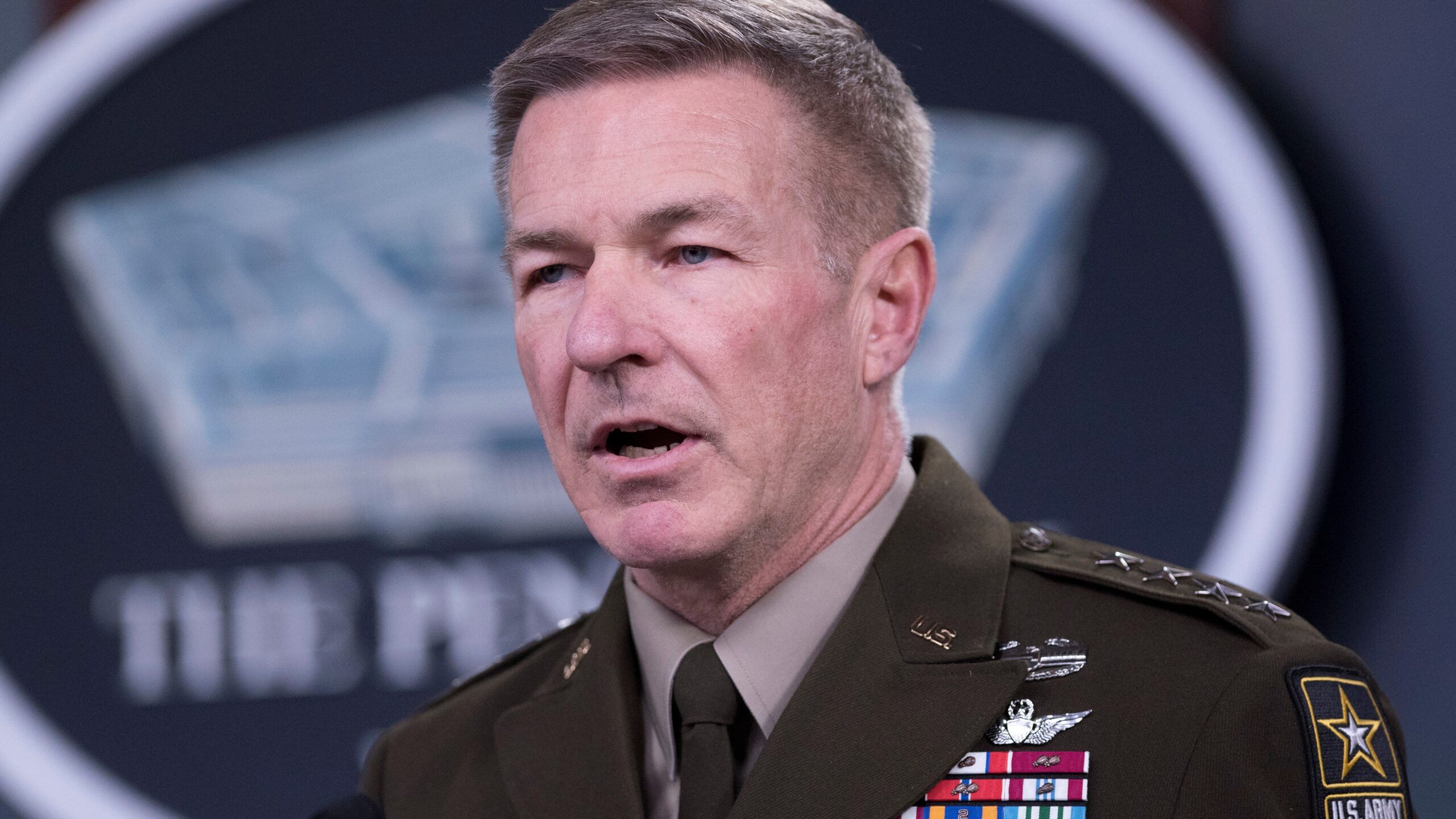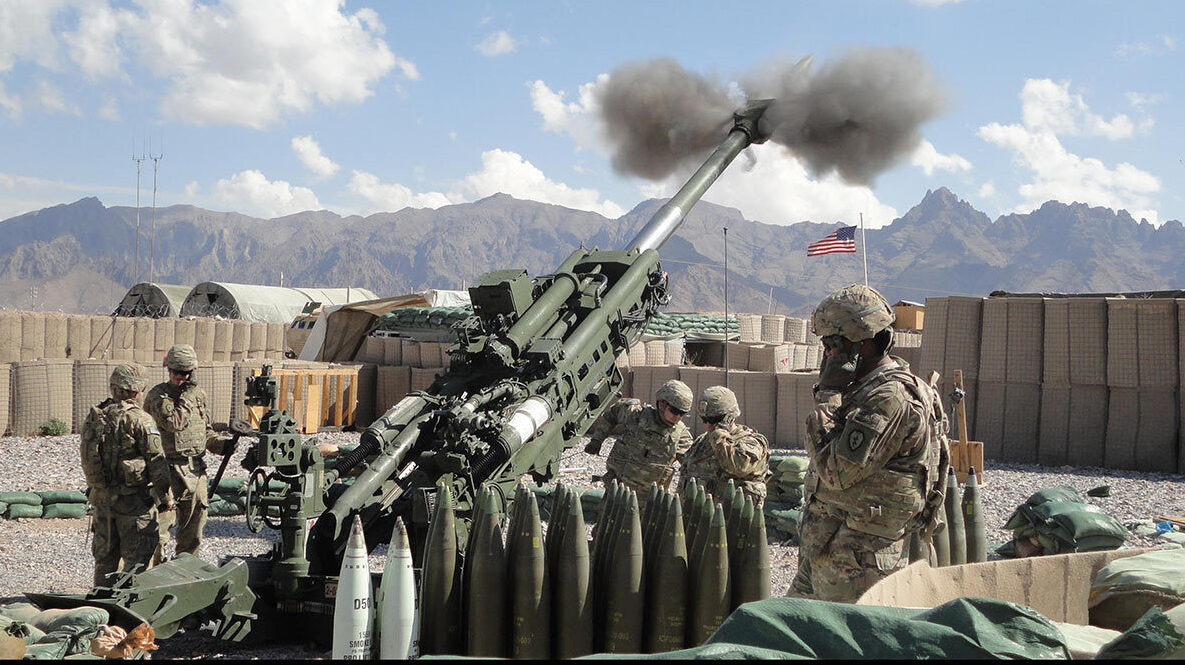
Chief of Staff of the Army Gen. James C. McConville. (DoD photo /Lisa Ferdinando)
WASHINGTON — As Ukraine’s underdog army pushes back the Russian invaders, what lessons should the American military take to heart?
The US Army’s top officer doesn’t hesitate: “We’re seeing the impact of long-range precision fires,” Gen. James McConville said at once. “The HIMARS has been a game changer for the Ukrainians.”
“The battle has shifted,” said McConville, the Army Chief of Staff, in a late September interview with Breaking Defense.
RELATED: How we fight: Army issues all-new handbook for multi-domain war
The first phase of the fight, a desperate defense against onrushing Russian armor, put a premium on man-portable anti-tank missiles like the US Javelin and British NLAW. The defenders also needed shoulder-fired anti-aircraft missiles, like the venerable Stinger, to take out Russian helicopters and ground-attack aircraft.
But as Ukraine stabilized the front and then went on the offensive, both sides shifted emphasis to artillery, seeking to disrupt enemy advances and soften up sectors for attack. Ukrainian forces urgently needed the ability to strike deeply and accurately at Russian supply depots, transport hubs, and other critical targets far behind the front lines. So the West began supplying long-range artillery systems, like the American HIMARS missile launcher.
“The Ukrainians initially had a lot of success with what I would call short-range weapons systems, like the Javelin, like the Stinger,” McConville said. But over time, “they found that having artillery – [like] the triple-7s [i.e. the M777 155 mm howitzer] — gave them much more capability. And now with HIMARS, [they have] the ability to engage across the depth of the battlefield.”
Long-Range, High-Tech, High Lethality
Such “Long-Range Precision Fires” – from GPS-guided howitzer shells to hypersonic missiles – have been the US Army’s No. 1 priority for research, development, and acquisition since 2017.
That’s when then-Chief of Staff of the Army Gen. Mark Milley, now chairman of the Joint Chiefs, used the annual Association of the US Army conference as a platform to set the service on a bold new course, refocusing from grueling guerilla warfare in the Middle East to high-tech conflict with China and Russia. McConville, who was Milley’s deputy, succeeded him as chief in 2019 and is now shepherding several programs the two men started into production.
“Those capabilities will be coming into the force starting next year,” McConville said. “That will fundamentally change how we do business.”
In 2023, the Army will get its first combat-ready prototypes for three new Long-Range Precision Fires systems:
- the hypersonic Dark Eagle missile, whose classified range is estimated at over 1,700 miles;
- the Mid-Range Capability (MRC), aka Typhon, which repurposes Navy SM-6s and Tomahawks for strikes at ranges of about 1,000 miles; and
- the Precision Strike Missile (PrSM), an all-new weapon designed to fit in existing HIMARS launchers and hit targets over 300 miles away.
By comparison, the farthest-striking missile currently available to the Army is the HIMARS-launched ATACMS (Army Tactical Missile System), with a maximum range of under 200 miles. And the US hasn’t actually given any ATACMS to Ukraine, just the 40-mile GMRLS rockets. That range is adequate for most targets in eastern Ukraine, but not for the vast distances of the western Pacific.
“We are developing systems that help us deal with the ranges and the speeds that are required in an environment that is much larger,” McConville said.
What’s more, the Army aims to upgrade these new weapons with sophisticated seekers that let them strike moving targets, including ships at sea. That makes them much more useful in the Pacific, historically a Navy-dominated theater, where the Army seeks a new role supporting the fleet with land-based anti-ship strikes.
“Long range precision fires gives you the ability to penetrate integrated air and missile defenses,” McConville said. “It gives you the ability to sink ships – which, again, can be very helpful if someone’s considering some type of amphibious operation.” (While McConville doesn’t offer examples, the most-discussed amphibious scenario is a Chinese attempt to land troops on Taiwan).
Of course, the US isn’t the only one developing such long-range precision-guided weapons. So is Russia – although it has resorted increasingly to indiscriminate strikes against civilians in Ukraine – and China. That puts a premium on missile defenses, McConville said, another of the Army’s six modernization priorities. But it also requires US forces to stay on the move and spread out, so they don’t provide big, static targets, like the Russian ammo dumps and air bases repeatedly ravaged by Ukrainian strikes.

Army soldiers fire an M777 howitzer. (US Army/ Laura Buchta)
Dispersion and mobility are tactics the Army must relearn after a generation in Afghanistan and Iraq, where US forces built up an extensive, static infrastructure of big bases, supply dumps, and well-appointed command posts.
“Commanders… will no longer be able to have the large command posts that they had in Afghanistan or Iraq… with stadium-type seats and a lot of big screens,” McConville said. “In the future, the battlefield will be so lethal, and there’ll be the ability to gather [targeting] information on where our command posts are, so we’re going to have to move them very, very quickly, and they’ll have to be dispersed and smaller.”
The new approach will require a change in mindset and doctrine – which leads to what McConville considers the most crucial weapons system: the human brain.
The Human Factor: Training & Doctrine
Western weapons have made a major difference in Ukraine, McConville told Breaking Defense. But weapons are nothing without soldiers to wield them. So, he said, what’s most important in this war – and every war – is the human factor: the Ukrainian soldiers’ will and skill.
Both have grown with eight years of combat experience and Western training since Russia’s initial, more limited invasion in 2014, when Ukraine ceded Crimea without a shot and then suffered heavy losses in the Donbas.
“This is not the Ukrainian army of 2014,” McConville emphasized. Today, he said, “the Ukrainian army is very competent and very committed. With the training that’s going on, that NATO is conducting for the Ukrainians, they pick up these [new] capabilities very quickly.”
Admittedly, much of Ukraine’s success is due to Russian incompetence. But McConville warns against understating either the Russian threat or the Ukrainian accomplishment in repelling it.
“We should not underestimate what the Ukrainians are doing,” he said. “They’ve done a lot of training, they have learned, they’re a learning organization, and they are performing very, very well on the battlefield.”
The US, likewise, has changed its training in recent years to emphasize high-intensity combat against a well-armed nation-state.
“If you go out to our national training centers, now, it’s large scale combat operations, where, over the last 20 years, we’d been focused on counterinsurgency, counterterrorism, irregular warfare,” McConville said. “If you have command posts, you have to move them often, or they’re going to be targeted…. Your command posts are going to be jammed, your computers are going to be taken away from you.”
That’s down to what the Army calls “long-range effects.” Those include not only Long-Range Precision Firepower, like HIMARS and hypersonics, but non-lethal tools like hacking and radio jamming to disable the command, control, and communications systems on which all modern militaries depend. The Army’s new Multi-Domain Task Forces are meant to combine firepower, electronic attack, and cyber warfare to cripple an enemy military’s digital nervous system — and potential enemies aim to do the same to US units.
That means commanders can’t count on live drone feeds from the battlespace or constant communications with frontline forces. It means junior officers must learn to fight in the dark, without detailed intelligence or instructions from higher headquarters.
“You will have to develop organizations that are trained, disciplined and fit,” McConvile said, “to the level that they can operate off of truly off mission command.”
That’s the doctrine whereby commanders tell subordinates what they must accomplish – “commander’s intent” – without micromanaging how they accomplish those missions. Planning, coordination, and orders still matter, but the emphasis is increasingly on adaptability, improvisation, and initiative.
“How we do command and control will change,” McConville said. “It’ll be much more focused on mission command. You’ll give orders that are more based on the commander’s intent, because you may not have the ability, in this very lethal and complex environment, to continue to give orders to your subordinate units. They may be dispersed, they may have to operate on intent, you may not be able to contact them.”
In such chaotic high-tech conflicts, drones, robots, and networks all play a useful role, McConville said, but such AI systems are also vulnerable to disruption and deception. Just as armies have long used camouflage to trick the human eye, he said, today they’re finding ways to “confuse the algorithm.” So while artificial intelligence can support human soldiers, McConville believes that it can’t replace them.
“You’re going to see our ground forces enabled by robotic combat vehicles and unmanned aerial systems,” he said. “We’re going to have autonomous vehicles, we’re going to have autonomous aircraft — but at the end of the day, I still think there’s a place for soldiers in the decision making loop, and you want them in a position where they can see the battlefield, because when you’re looking through cameras and drones, you can’t get the full picture.”
“At the end of the day, people are your greatest strength,” McConville emphasized. “They’re the most important weapons system.”
“We equip our soldiers with the best gear, but having soldiers that are willing to fight and defend their country in a very lethal battlefield is extremely important,” he said. “That’s what we’re seeing in Ukraine.”
“What makes the difference is the will to fight. All conflicts are a battle of wills.”























